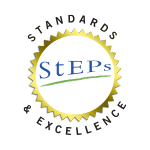Exciting changes are happening at the 980 organizations taking part in the StEPs program (Standards and Excellence Program for History Organizations).
Our “StEPs Spotlight” blog series highlights accomplishments by participating organizations.
Below is another example of how StEPs is helping organizations take a leap forward by improving policies and practices, opening lines of communication, and setting goals for a bright future.
La Crosse County Historical Society
La Crosse, WI
The La Crosse County Historical Society is a regional history museum, originally founded as a “Pioneers Club” in 1898. LCHS has grown into a 501(c)3 with a small permanent museum and an exceptional house museum, the Hixon House. We have a staff of four and a large cadre of volunteers, including house docents, collections interns, re-enactors, and tour guides. LCHS has been a member of AASLH since 1979, and joined the StEPs program in January 2017.
Tell us how your organization is making its way through the program.
We have started at the beginning with the Mission, Vision, and Governance section and our aim is to hit at least Basic levels across all sections, then begin to strive for Good and Better levels. Because we have had a curator on staff for the last seven years, we know we can achieve much better than Good right out of the gate in the Stewardship of Collections section, while in other sections, we are going to have a lot more work to do. So we might do Stewardship next, just to give us a sense of what we can accomplish. We wanted to start with Mission, Vision, and Governance because it is the section that most closely involves the Board of Directors, and this gets them fully engaged and aware of what the program can do for us as an institution.
What would you say is the most significant change or improvement within your organization as a result of taking part in StEPs?
So far, the work has been entirely at the board level, and their sense of a shared purpose and commitment has grown from the close examination of our mission and values. We are still in the beginning stage of implementing StEPs, and we now need to do two things: publicize it more, and engage more stakeholders in the process. In our newsletter, we have quarterly reports to members on our progress, and it will get promoted on our website and other social media. Bringing in more staff and volunteers should give us more energy, and also elevate their understanding and professionalism.
Has your organization been able to use StEPs as leverage in fundraising or in other ways?
This is exactly our hope, and when it happens we will let you know! StEPs is a very strong “capacity builder” that is a great stepping stone to increased professionalism. It can only serve to expand grantors’ confidence in us as an institution, and I already think it is having a good effect on our own confidence.
What advice do you have for organizations just starting in StEPs?
My advice would be to just go ahead and start. Whatever progress you make is good progress. Self-awareness for institutions is a good thing, and StEPs will lead you through a process of measuring your organization against industry standards. We are nearly finished with the Mission, Vision, and Governance section, which is the underpinning for everything else. Because it’s always about the mission, right?






